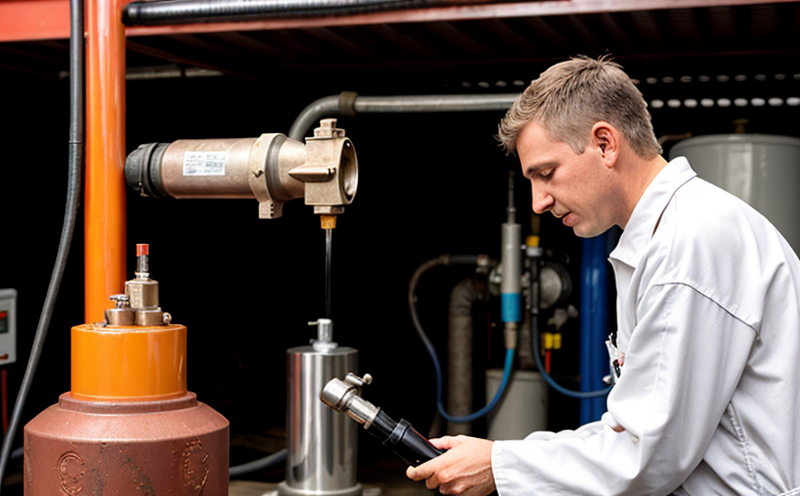ISO 12156 Lubricity Testing of Aviation Fuels (HFRR)
The ISO 12156 lubricity test using High-Frequency Reciprocating Rig (HFRR) is a critical procedure for ensuring the quality and reliability of aviation fuels. This test measures the tendency of fuel to cause wear on engine components, which can lead to reduced engine life and increased maintenance costs. Compliance with this standard is essential in aerospace & aviation industries where precision and safety are paramount.
The HFRR test simulates the lubricating performance of aviation fuel under high-pressure and high-frequency reciprocating conditions that mimic real-world engine operating conditions. This method evaluates the wear caused by solid particles present in the fuel, which can be introduced during refining or during storage. The primary objective is to ensure that the fuel does not cause excessive wear on the engine components.
The testing process involves placing a small sample of aviation fuel into an HFRR machine and subjecting it to specific parameters such as temperature, pressure, and frequency. During this process, a steel ball is reciprocated at high speed in contact with a steel disc. The friction between these surfaces generates wear debris, which are then analyzed for particle size distribution and composition.
The results of the HFRR test provide valuable insights into the fuel's lubricating properties and its potential to cause wear on engine components. These findings help ensure that fuels meet the stringent requirements set by industry standards like ISO 12156:2018, which specifies the method for determining the tendency of aviation turbine fuels to cause wear in engines.
The importance of this test cannot be overstated. It is a key component in quality control processes and helps prevent costly engine failures due to poor lubrication. By ensuring that fuels meet these stringent standards, manufacturers and suppliers can enhance the reliability and performance of their products, thereby improving overall safety and efficiency in aerospace & aviation operations.
In summary, ISO 12156 lubricity testing is a vital procedure for maintaining high fuel quality in the aviation industry. It helps identify potential issues early on, ensuring that only the highest-quality fuels are used, which ultimately contributes to safer and more efficient aircraft operations.
Industry Applications
The ISO 12156 HFRR test is widely utilized across various sectors within aerospace & aviation. Quality managers and compliance officers rely on this method to ensure that the fuels they supply meet the required standards. R&D engineers use it to develop new formulations that enhance lubrication properties while minimizing wear. Procurement teams also benefit from this testing as it helps them select suppliers who consistently deliver fuel of high quality.
- Quality Assurance: Ensuring compliance with ISO 12156 standards is crucial for maintaining the integrity of fuels used in aviation applications.
- Research & Development: Engineers can use HFRR results to refine formulas and improve lubrication performance.
- Safety: By preventing wear that could lead to engine failures, this test enhances overall safety in aircraft operations.
- Efficiency: Reliable fuels contribute to more efficient engine performance, reducing fuel consumption and emissions.
The industry applications of ISO 12156 lubricity testing extend beyond just the production phase. It also plays a significant role in maintenance programs where ongoing monitoring ensures that fuels continue to meet quality benchmarks throughout their lifecycle.
Eurolab Advantages
At Eurolab, we provide comprehensive ISO 12156 lubricity testing services tailored specifically for the aerospace & aviation sectors. Our state-of-the-art facilities and experienced technicians ensure that every test is conducted with precision and reliability.
- Precision: Our high-tech equipment guarantees accurate measurements under controlled conditions.
- Reliability: With years of experience in conducting such tests, we maintain a track record of delivering consistent results.
- Compliance: We adhere strictly to international standards like ISO 12156:2018, ensuring that all our test procedures are up-to-date and valid.
- Expertise: Our team comprises experts in fuel testing who understand the nuances of aviation fuels.
We offer a full suite of services including sample preparation, instrument calibration, data analysis, and report generation. This holistic approach ensures that our clients receive comprehensive support throughout their testing needs. Additionally, we provide detailed reports with actionable insights that help our clients make informed decisions about fuel quality.
Our commitment to excellence is reflected in the numerous certifications and accreditations held by Eurolab. These include ISO 17025 accreditation for our laboratories, which guarantees that all our testing processes meet international standards of competence and reliability.





